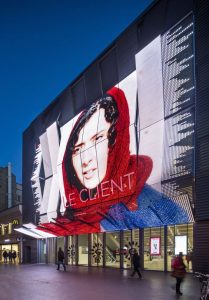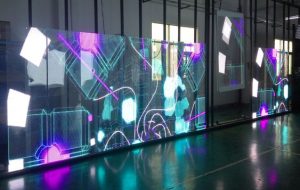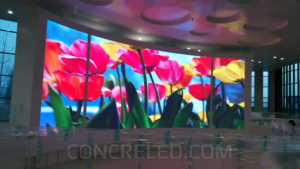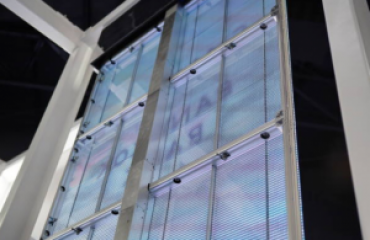
Transparent LED screen for business
In recent years, there has been a growing trend of businesses turning to Transparent LED screens to enhance their customer experience and stay ahead of the competition in the retail industry. These screens allow for the creation of visually stunning displays that capture the attention of shoppers and provide an immersive shopping experience.
As the retail industry continues to evolve, businesses need to adapt to new technologies to remain competitive. The use of transparent LED screens is one way that retailers can differentiate themselves and offer something unique to their customers. These screens not only provide a modern and futuristic look, but they also offer practical benefits such as increased visibility, better product showcasing, and improved customer engagement.
In this discussion, we will explore the benefits of transparent LED screens in retail, and how they are shaping the future of the industry. We will provide examples and data to showcase the impact that these screens can have on the success of a retail business.
Benefits of Using Transparent LED Screens in Retail
Transparent LED screens are becoming increasingly popular in the retail industry due to the numerous benefits they offer. These displays are revolutionizing the way retailers interact with customers, providing a unique and immersive experience that goes beyond traditional displays. Here are some of the key benefits of using transparent LED screens in retail:
Enhancing customer experience with visually appealing displays
The visually appealing displays created by transparent LED screens can significantly enhance the customer experience, leading to increased engagement and ultimately, higher sales. For example, in the hospitality and entertainment industry, transparent LED screens can be used to create unique and engaging experiences for guests, such as interactive menus or immersive digital art installations.
In the retail industry, transparent LED screens can be used to create captivating window displays that showcase the latest products and promotions. This can be especially valuable for attracting foot traffic and increasing sales, as customers are more likely to enter a store with an eye-catching display. According to a study by the Point of Purchase Advertising International, a well-designed window display can increase foot traffic by up to 50%.
In addition, transparent LED screens can also be used to enhance the customer experience in transportation and automotive settings. For example, airports and train stations can use transparent LED screens to provide real-time flight or train information, while car showrooms can use them to showcase the latest models in a dynamic and engaging way.
Creating unique, immersive in-store experiences
Another example of using transparent LED screens to create immersive in-store experiences is by creating interactive displays that allow customers to learn more about products in a fun and engaging way. For instance, a cosmetics store could use a transparent LED screen to showcase their range of products and demonstrate makeup application techniques. Customers can see the products being applied on models on the screen and can even try the techniques on themselves using mirrors placed strategically around the display.
By using transparent LED screens in this way, retailers can create a unique and memorable shopping experience for their customers, which can help build brand loyalty and drive sales. In fact, according to a study by Mood Media, 78% of shoppers said that sensory experiences such as interactive displays made them more likely to make a purchase. This highlights the importance of creating an immersive in-store experience that engages customers and keeps them coming back for more.
Providing real-time product information and updates
In addition to providing real-time product information and updates, transparent LED screens can also be used to display information such as product features, pricing, and reviews. For example, a store selling electronic products could use a transparent LED screen to showcase product features such as battery life, screen size, and camera quality. They could also display product pricing and reviews from other customers, providing valuable information to potential buyers.
According to a report by MarketsandMarkets, the global transparent display market is expected to grow from USD 408 million in 2020 to USD 4.5 billion by 2025, at a compound annual growth rate (CAGR) of 61.2% during the forecast period. The increasing demand for transparent displays in retail, automotive, and hospitality sectors is driving the growth of this market. The report also highlights the growing adoption of transparent LED screens in various industries such as retail, hospitality, automotive, and healthcare.
In addition, a survey by Nielsen found that digital displays, including LED screens, have a significant impact on customer behavior in retail environments. The survey found that 69% of customers agreed that digital displays catch their attention, while 71% agreed that digital displays help them learn about products. Furthermore, 62% of customers said that digital displays make them more likely to purchase products.
Boosting sales through effective advertising and promotions
In addition to the benefits mentioned above, the use of transparent LED screens in retail can also provide valuable data insights that can inform future business decisions. By using sensors and other technology, retailers can track customer engagement with the displays, measure foot traffic, and gather other data that can be used to optimize store layouts, product placement, and marketing strategies.
Moreover, the use of transparent LED screens in retail has been shown to have a positive impact on consumer attitudes and behavior. According to a study conducted by Signify, a lighting and electronics company, stores that used dynamic lighting and signage experienced a 9% increase in sales, a 6% increase in customer satisfaction, and a 6% increase in foot traffic. This highlights the potential for transparent LED screens to not only enhance the customer experience but also drive sales and revenue for retailers.
In terms of statistics, the global transparent LED display market is projected to grow from $467 million in 2020 to $4.4 billion by 2027, at a compound annual growth rate of 36.9% during the forecast period. This growth is driven by factors such as the increasing demand for energy-efficient displays, the growing adoption of digital signage in retail and hospitality, and the rising popularity of transparent LED displays in outdoor advertising and sports events.
Applications of Transparent LED Screens in Retail

Transparent LED screens for business
Transparent LED screens are revolutionizing the way retailers showcase their products and promote their brand. With their innovative design and advanced technology, they offer a variety of applications that help retailers stay ahead of the competition. In this section, we will explore the different applications of transparent LED screens in retail.
Storefront Displays
One of the most effective ways to attract foot traffic is through storefront displays. A transparent LED screen can be installed on the storefront window to showcase the store’s products and promotions. These displays can be designed in various shapes and sizes, depending on the storefront’s architecture, and can be customized to create unique and eye-catching designs that grab customers’ attention.
Example: Samsung’s flagship store in New York City uses a 29-foot-tall transparent LED screen on its storefront to display high-resolution product images and videos. This has helped the store stand out and attract customers from across the city.
Window Displays
Retailers can use transparent LED screens in their window displays to showcase their products and promotions in a visually appealing way. These displays can be designed to provide a 360-degree view of the products and can be updated in real-time to showcase new products or promotions.
Example: Nike’s flagship store in New York City uses a transparent LED screen in its window display to showcase its latest products. The screen provides a 360-degree view of the products and can be updated in real-time to showcase new arrivals.
In-Store Displays
Transparent LED screens can be used in-store to showcase products and promotions in a visually appealing way. These displays can be customized to provide a 360-degree view of the products and can be interactive, allowing customers to explore the product features in detail.
Example: Adidas’ flagship store in London uses a transparent LED screen to showcase its products in an innovative way. The screen is installed in the middle of the store and provides a 360-degree view of the products. Customers can interact with the screen to explore the product features and learn more about the brand.
Interactive Displays
Transparent LED screens can be made interactive, allowing customers to engage with the brand and its products in a unique way. These displays can be customized to provide a personalized experience for each customer, making them feel more connected to the brand.
Example: Levi’s flagship store in New York City uses a transparent LED screen to create an interactive display for its customers. The screen allows customers to customize their own jeans and see the changes in real-time, making the shopping experience more fun and engaging.
Digital Signage
Transparent LED screens can be used as digital signage to provide real-time product information, such as prices, availability, and product features. These displays can be updated in real-time to ensure that customers have the most up-to-date information.
Example: Sephora’s flagship store in New York City uses transparent LED screens as digital signage to provide product information and promotions to its customers. The screens are updated in real-time, ensuring that customers have the most accurate information.
Statistics show that the use of digital signage and displays in retail stores can increase sales by up to 30%. Furthermore, a study by Intel found that digital signage in stores can increase the time customers spend in-store by up to 30%.
Case Studies of Successful Implementations

Transparent LED screens for business
There are several examples of retailers successfully incorporating transparent LED screens into their stores. One such example is the Adidas flagship store in New York City. The store features a transparent LED wall that is 30 feet tall and 13 feet wide, allowing customers to see through the display to the street outside. The wall features Adidas branding and displays product information and promotions. The screen has been shown to increase foot traffic and engagement with the Adidas brand.
Another example is the H&M flagship store in Seoul, South Korea. The store features a large transparent LED screen that covers the entire storefront. The screen displays a range of content, including product information, promotions, and interactive displays. The screen has been credited with increasing foot traffic to the store and boosting sales.
According to a study by Grand View Research, the global market for transparent LED screens is expected to grow at a compound annual growth rate of 44.3% from 2021 to 2028. The study cites the increasing adoption of transparent LED screens in retail, as well as in the automotive, healthcare, and hospitality industries, as driving factors.
Additionally, a survey conducted by Nielsen found that 59% of shoppers enjoy watching videos while they are in a store, and 70% of shoppers say that digital signage catches their attention more than traditional displays. This highlights the potential for transparent LED screens to increase customer engagement and drive sales.
Overall, the successful implementation of transparent LED screens in retail stores can lead to increased foot traffic, engagement with the brand, and ultimately, increased sales. As technology continues to advance, it’s likely that more retailers will incorporate transparent LED screens into their stores to stay ahead of the competition and enhance the customer experience.
Challenges and Considerations

Transparent LED screens for business
Implementing transparent LED screens in a retail environment comes with its own set of challenges and considerations. Some of the most important ones include technical considerations, cost and budget considerations, and compatibility with existing store design and layout.
Firstly, installation and maintenance of transparent LED screens require technical expertise and specialized equipment. The screens must be properly mounted and wired to ensure their longevity and reliability. Moreover, they require regular maintenance to ensure that they continue to operate at optimal levels.
Secondly, the cost and budget considerations for implementing transparent LED screens can be significant. Transparent LED screens are generally more expensive than traditional display screens, which can be a deterrent for some retailers. However, the benefits they offer in terms of customer engagement and sales may outweigh the cost.
Finally, ensuring compatibility with existing store design and layout is crucial. Transparent LED screens must be integrated seamlessly into the store’s overall aesthetic, and should not detract from the customer experience. In some cases, retrofitting existing stores with transparent LED screens may not be feasible or practical.
For example, Nike implemented transparent LED screens in their flagship store in New York City. The installation required technical expertise and specialized equipment, and had to be carefully integrated into the store’s existing design. However, the screens proved to be a major success in attracting foot traffic and engaging customers, leading to a boost in sales.
Overall, while there are certainly challenges and considerations to be taken into account when implementing transparent LED screens in retail, the potential benefits are significant. With proper planning and execution, transparent LED screens can provide a unique and effective way to enhance the customer experience and boost sales.
Conclusion
In conclusion, transparent LED screens have a huge potential to transform the retail industry. They offer a wide range of benefits such as enhancing customer experience, creating immersive in-store experiences, providing real-time product information, and boosting sales through effective advertising and promotions.
Successful implementation of transparent LED screens in retail has been observed in numerous case studies. One such example is Adidas’ flagship store in New York City which installed a massive transparent LED screen that displays high-resolution images of athletes, products, and social media content, creating a captivating shopping experience for customers. As per a study by Grand View Research, the global market for transparent LED screens is expected to grow at a CAGR of 47.2% from 2021 to 2028.
However, there are also technical and budget considerations that must be taken into account. Installation and maintenance require skilled professionals, and costs can vary depending on the size and complexity of the project. Additionally, the compatibility of transparent LED screens with existing store design and layout should also be considered.

